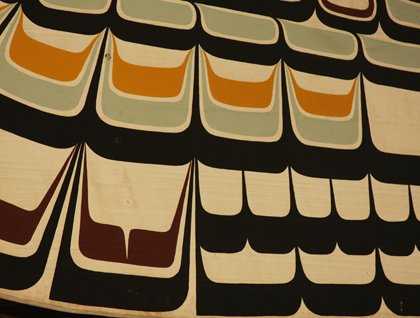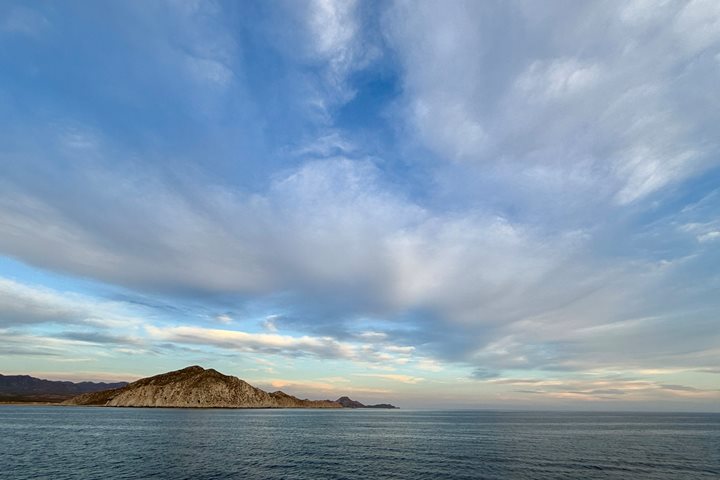Overlapping patterns radiate across the Northwest Coast – the rippling wake of a ship, the coming of another spring, or repeating feathers painted on a totempole.
We spent the day along the north coast of Vancouver Island. Here, at the end of Johnstone Strait, the waters are intricately island-studded, supporting natural and cultural history of remarkable richness. Leaving Johnstone Strait, we entered Blackfish Sound. This channel is named for one of the region’s most famous denizens. When salmon migrate, these waters are thick with killer whales. Turning southward, we neared Mimkwamlis or Village Island. We saw the slumping houses here, all returning to the earth. The scene was picturesque, though melancholy. This town holds an important place in Native history, for it was here in 1921 that Dan Cranmer’s potlatch was raided by police, resulting in the confiscation of the participants’ ceremonial regalia.
Returning to the north, we found a killer whale. At this time of year, seeing killer whales is a rather chancy thing, but, considering our spectacular experience with whales last evening, we soon left this singleton.
Just after lunch we docked at Alert Bay. Home of the Namgis tribe of the Kwakwakawakw Nation, Alert Bay may be the most culturally significant town on the Northwest Coast. And we would soon find out why.
We walked to the ‘Umista Cultural Center. After long “imprisonment” in Ottawa, the regalia, judicially stolen following the Village Island potlatch, has come home, and is displayed here. At ‘Umista, Lillian, a local guide, took us through the potlatch collection, combining cultural information with personal reflections. The gift shop at ‘Umista alone is worth the visit. We saw many masks, drums, as well as a very ample bookstore.
Next we went to the bighouse. This house is one of the first traditional houses built in modern times, and has hosted more potlatches than anywhere in history! A huge image of a seamonster covers the housefront, and giant houseposts, carved as bears, thunderbirds and other creatures support the mighty roof. Donning “cedarbark” headrings, we entered the house and were welcomed by the Tsasatla Dancers. This group has formed to teach kids in Alert Bay about their dancing traditions. We saw many dances. Button blankets swirled during the Entrance Dance; fearsome Hamatsas gave the cannibal cry, Tlasula dancers shook their whiskery headdresses, and an eerie Bookus stalked about the dancefloor. Finally, most of us participated in the Amlam, or Fun Dance. It was interesting to see the dances, and perhaps even more gratifying to witness the cultural resiliency of the Kwakwakawakw, and the passing on of a living tradition.
Back on the ship, we resumed our northbound voyage, heading for wider vistas, higher mountains, and wilder country.







